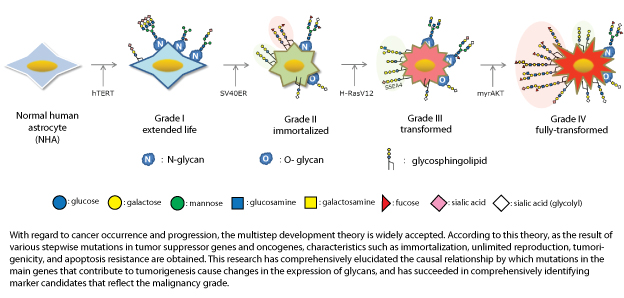Elucidation of Changes in the Appearance of Cells Accompanying Tumor Transformation, Using Comprehensive Glycomic Analysis of Model Cells
Research Press Release | July 14, 2015

| Press Release | ||
|---|---|---|
| Key Points | ・Comprehensive glycan 1 expression analysis was performed on model cells that mimic WHO grade I-IV2 malignant glioma—one type of brain tumor—and specific glycan expression patterns that reflect the malignancy grade of tumor transformation were clarified.
・It was possible to comprehensively extract causal relationships between abnormalities in oncogenes and tumor suppressor genes, and glycan expression. ・Stepwise changes in glycan expression accompanying the progression of glioma are potential biomarker candidates that reflect the malignancy grade. |
|
| Overview |
This research reports on an approach that performs comprehensive expression analysis of glycoproteins and glycosphingolipids, using unique model cells that mimic WHO grade I-IV malignant glioma. Cells were created based on the multistep theory of tumorigenesis3 in order to comprehensively follow the changes in glycan expression that accommodate the progression of glioma. Multiple dynamic changes in glycan expression were detected during cancer progression accompanying stepwise mutations of oncogenes and tumor suppressor genes. Interesting to note, is that many changes are transient. This suggests that the stepwise changes in glycan expression that accompany tumor transformation could be useful in determining early diagnosis, prognosis, and treatment effectiveness. Notes: 1) Glycan: A substance in which sugars are connected as in a chain. Glycans often combine with proteins and lipids, and are expressed on the cell surface. 2) WHO grade I-IV malignant glioma: A tumor that originates in glial cells within the brain. Brain tumors are described by grades that show a “malignancy grade”, rather than by stages that express progression as in cancer of other organs. WHO (the World Health Organization) classifies the malignancy grades of brain tumors from Grade I, which is low malignancy, through Grade IV, the highest. 3) Multistep theory of tumorigenesis: The idea that cancers, including gene mutations, progressively become cancerous. |
|
| Inquiries |
Coordinating Office, Future Drug Discovery and Medical Care Innovation Project, Hokkaido University Publicity liaison: Ms. Wada Phone: +81-11-706-7798 FAX: +81-11-706-7799 E-mail: innovation@cris.hokudai.ac.jp |
|
|
Japanese Link |
がん化に伴って細胞の顔つきが変わる様子をモデル細胞の包括的な糖鎖解析によって解明 (2015.7.3) | |
| Publications | Comprehensive Glycomics of a Multistep Human Brain Tumor Model Reveals Specific Glycosylation Patterns Related to Malignancy, PLOS ONE (2015.7.2) | |
